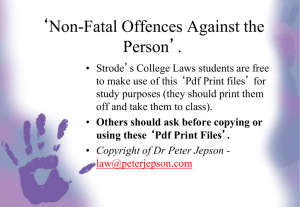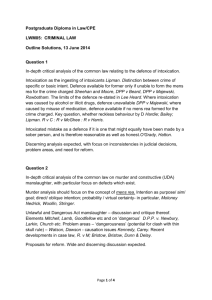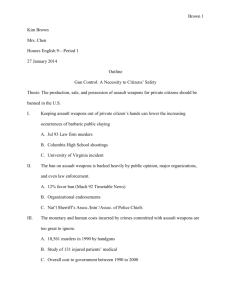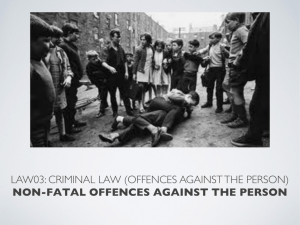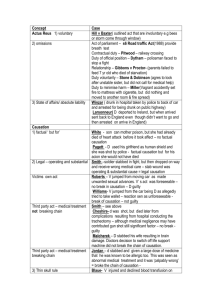Non-Fatal Offences PowerPoint
advertisement
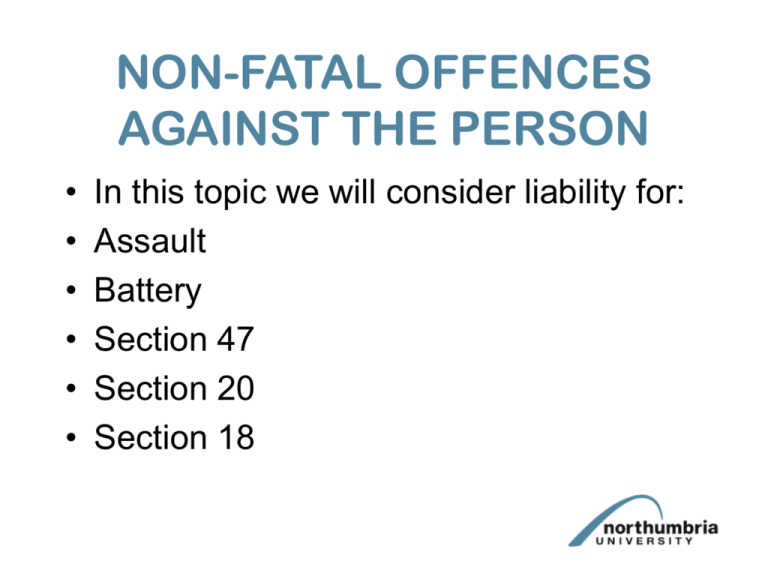
NON-FATAL OFFENCES AGAINST THE PERSON • • • • • • In this topic we will consider liability for: Assault Battery Section 47 Section 20 Section 18 • When answering questions involving non-fatal offences against the person, which offence should one start with? ASSAULT AND BATTERY • Both are statutory offences (DPP v Little (1991)). • The charge is one of assault or battery contrary to s.39 Criminal Justice Act 1988. • The term “common assault” encompasses assault and battery (Lynsey (1995)). Assault • Definition of assault – any act by which D intentionally/recklessly causes V to apprehend immediate and unlawful personal violence. • Does this rule out assault by omission, see Fagan v Metropolitan Police Commissioner (1969)? • Words alone may constitute an assault (Constanza (1997). • It is not a requirement of assault that V can see her assailant. Thus, an assault can be committed in the dark or over the telephone. CONDITIONAL ASSAULTS • Examples • D says to V: • (a) “I would hurt you if it wasn’t for… • (b) “I will hurt you unless...” • In example 1, the words used by D make clear that, for whatever reason, he won’t do anything to V. There is, therefore, no assault. This is illustrated by Tuberville v Savage (1669). • In example 2, the words used show that D will hurt V unless V complies with the specified condition. D is, therefore, liable for an assault on V. This is illustrated by Read v Coker (1853). How strictly is “immediate” interpreted? • Immediate is interpreted quite flexibly, see Smith v Superintendent of Woking Police Station (1983) which adopted a broad view of immediate. • Also see Constanza and Ireland & Burstow (1997) HL. Battery • Definition – any act by which D intentionally/recklessly inflicts unlawful personal violence. Can contact with the clothes worn by a person constitute a battery? • Relevant caselaw: • Day (1845) - contact with the clothes worn by a person can constitute a battery as the person of V includes the clothes on his back. • Thomas (1985) - it is not necessary that V should be able to feel the impact through his clothes. Can a battery involve indirect violence? • Although most batteries are directly inflicted, e.g. D hitting V, it is not essential that the violence be direct. See, for example, Martin (1881) and DPP v K (1990). Mens rea of assault and battery • Both assault and battery can be committed intentionally or recklessly, see Venna (1978). • Recklessness is subjective, see Spratt (1990). ASSAULT OCCASIONING ACTUAL BODILY HARM – S.47 OAPA 1861 • Definition – Assault occasioning actual bodily harm • Actus reus • Assault means assault or battery • For the meaning of occasioning, see Roberts (1971). • For the meaning of actual bodily harm, see Chan-Fook (1994). • Examples • It is possible to commit the s.47 offence by one or more silent phone calls (Ireland & Burstow). Mens rea of s.47 • Only the mens rea for assault or battery need be proven (Savage & Parmenter (1991) HL). • It is not, therefore, necessary to prove D foresaw a.b.h. only that he intended or was subjectively reckless as to whether V apprehend or sustain unlawful personal violence. S.20 • Definition – unlawful and malicious wounding or inflicting gbh • 2 offences created by the section • unlawfully wounding • unlawfully inflicting gbh Wounding offence • For what constitutes a wound, see JCC v Eisenhower (1984)). Grievous bodily harm • It is sufficient for the trial judge to direct the jury that gbh simply means “serious harm” (Saunders (1985)). • Examples Is s.20, which refers to "inflict gbh," narrower in scope than s.18 which refers to "cause gbh"? • In Ireland & Burstow, the court held that gbh can be inflicted where no personal violence has been applied directly or indirectly to the body of V - the application of physical force is not required. • Thus, there does not appear to be any distinction between cause and inflict. Mens rea • The mens rea is “maliciously”. • This means intentionally or subjective recklessness (Savage and Parmenter) as to some physical harm (Mowatt (1968)). • Intention to frighten is not sufficient for s.20 • (Sullivan (1981)). S.18 • Definition – unlawfully and maliciously wound or cause gbh with intent to do gbh. • 2 offences created by the section – unlawfully wounding with intent and unlawfully causing gbh with intent • Actus reus is same as for s.20 save that the word cause is used instead of inflict. • Mens rea is intention only, recklessness will not suffice (Belfon (1976)). • The test for intention is the same as for murder (Bryson (1985)).

